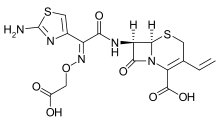Cefixime
 | |
| Clinical data | |
|---|---|
| Trade names | many[1] |
| AHFS/Drugs.com | Monograph |
| MedlinePlus | a690007 |
| Pregnancy category |
|
| Routes of administration | by mouth (capsule or suspension) |
| ATC code | |
| Legal status | |
| Legal status |
|
| Pharmacokinetic data | |
| Bioavailability | 40% to 50% |
| Protein binding | Approximately 60% |
| Biological half-life |
Variable Average 3 to 4 hours |
| Excretion | Kidney and biliary |
| Identifiers | |
| |
| CAS Number | |
| PubChem CID | |
| DrugBank | |
| ChemSpider | |
| UNII | |
| KEGG | |
| ChEBI | |
| ChEMBL | |
| ECHA InfoCard | 100.119.331 |
| Chemical and physical data | |
| Formula | C16H15N5O7S2 |
| Molar mass | 453.452 g/mol |
| 3D model (JSmol) | |
| |
| |
| | |
Cefixime is an antibiotic useful to treat a number of bacterial infections. This includes otitis media, strep throat, pneumonia, urinary tract infections, gonorrhea, and Lyme disease. For gonorrhea typically only one dose is required.[2] In the United States it is a second line treatment to ceftriaxone for gonorrhea. It is taken by mouth.[3]
Common side effects include diarrhea, abdominal pain, and nausea. Serious side effects may include allergic reactions and Clostridium difficile diarrhea.[3] It is not recommended in people with a history of a severe penicillin allergy.[2] It appears to be relatively safe during pregnancy.[4] It is in the third generation cephalosporin class of medications. It works by disrupting the bacteria's cell wall resulting in its death.[3]
Cefixime was approved for medical use in the United States in 1989.[3] It is on the World Health Organization's List of Essential Medicines, the most effective and safe medicines needed in a health system.[5] It is not available as a generic medication in the United States.[6] The wholesale cost in the developing world is about 0.26 to 2.09 USD per dose.[7] In the United States a course of treatment costs about 100 to 200 USD as of 2015.[6]
Medical uses
Cefixime treats infections of the:
Ear: Otitis caused by Haemophilus influenzae, Moraxella catarrhalis and Streptococcus pyogenes.
Sinuses: Sinusitis.
Throat: Tonsillitis, pharyngitis caused by Streptococcus pyogenes.
Chest and lungs: Bronchitis, pneumonia caused by Streptococcus pneumoniae and Haemophilus influenzae.
It is also used to treat typhoid fever.[8]
Spectrum of bacterial susceptibility
Cefixime is a broad spectrum cephalosporin antibiotic and is commonly used to treat bacterial infections of the ear, urinary tract, and upper respiratory tract. The following represents MIC susceptibility data for a few medically significant microorganisms:[9]
- Escherichia coli: 0.015 µg/mL - 4 µg/mL
- Haemophilus influenzae: ≤0.004 µg/mL - >4 µg/mL
- Proteus mirabilis: ≤0.008 µg/mL - 0.06 µg/mL
Mechanism of action
The bactericidal action of Cefixime is due to the inhibition of cell wall synthesis. It binds to one of the penicillin binding proteins (PBPs) which inhibits the final transpeptidation step of the peptidoglycan synthesis in the bacterial cell wall, thus inhibiting biosynthesis and arresting cell wall assembly resulting in bacterial cell death.
Absorption
Only 40-50% is absorbed from the GI tract (oral bioavailability). Absorption may be decreased when taken with food. Average peak concentration after administration of oral suspension is approximately 25-50% greater than the peak concentration following oral tablet or capsules administration.[10]
Distribution
It has high concentrations in bile and urine. It can cross the placenta and its protein binding capacity is 65%.
It is always better to perform appropriate cultures and susceptibility studies to determine the causative organism and its sensitivity to cefixime.
Contraindications
Cefixime is contraindicated in patients with known sensitivity or allergies to cephalosporin class of antibiotics. As Cefixime is a third generation cephalosporin, it is not contraindicated for patients with a true penicillin allergy.[11]
Adverse effects
Adverse drug reactions include diarrhea, dyspepsia, nausea and vomiting. Hypersensitivity reactions like skin rashes, urticaria and Stevens-Johnson syndrome have been reported. Though thrombocytopenia has been reported for many cephalosporins, it has not been reported for cefixime. There is no specific antidote for Cefixime overdosage. Gastric lavage may be performed. Dialysis will not remove Cefixime in significant quantities.
Drug interactions
- Alcohol - No major interaction has been observed between cefixime and alcohol.[12]
History
It was sold under the trade name Suprax 125 in the USA until 2003 when it was taken off the market by drug manufacturer Wyeth after its patent expired.
Trade names
Cefixime is marketed under many trade names worldwide.[1]
References
- 1 2 "Cefixime - Drugs.com". www.drugs.com. Retrieved 10 December 2016.
- 1 2 WHO Model Formulary 2008 (PDF). World Health Organization. 2009. p. 107. ISBN 9789241547659. Retrieved 8 December 2016.
- 1 2 3 4 "Cefixime". The American Society of Health-System Pharmacists. Retrieved 8 December 2016.
- ↑ "Cefixime (Suprax) Use During Pregnancy". www.drugs.com.
- ↑ "WHO Model List of Essential Medicines (19th List)" (PDF). World Health Organization. April 2015. Retrieved 8 December 2016.
- 1 2 Hamilton, Richart (2015). Tarascon Pocket Pharmacopoeia 2015 Deluxe Lab-Coat Edition. Jones & Bartlett Learning. p. 86. ISBN 9781284057560.
- ↑ "Cefixime". International Drug Price Indicator Guide. Retrieved 8 December 2016.
- ↑ "Mechanism of Therapeutic Effectiveness of Cefixime against Typhoid Fever". Antimicrobial Agents and Chemotherapy. September 2001. Retrieved 7 April 2016.
- ↑ http://www.toku-e.com/Assets/MIC/Cefixime%20trihydrate.pdf
- ↑ "SUPRAX Package Insert" (PDF). Lupin Pharmaceuticals, Inc. March 2013. Retrieved 7 April 2016.
- ↑ http://www.cks.nhs.uk/gonorrhoea/prescribing_information/prescribing_information/cephalosporins_ceftriaxone_or_cefixime%5B%5D
- ↑ Choices, N. H. S. "Medicines information links". www.nhs.uk. NHS Choices. Retrieved 22 August 2016.